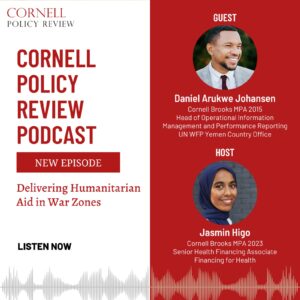
By Jialu Li
Edited by Courtney Schneider
______________________________________________________________________________
Agriculture is a main source of income for rural communities in many developing countries, where more than 2 billion people depend on smallholder farms for their livelihood.[1] However, the agricultural sector is also particularly risk-prone. All actors, from individual farmers to big food corporations, face uncertainties caused by five major risk areas: production, market-based, financial, institutional, and human.[2]
Risk management approaches among smallholder farmers have traditionally included cultivating a mix of crops, staggering crop plant dates, diversification of activities, and alignment of activities with communities and value chain players.[3] However, agriculture insurance is developing as a new risk-management tool in emerging markets. This coverage spans various types of crop insurance, including multi-peril crop insurance, named-peril insurance, and index-based insurance.[3]
Index-based Insurance and Weather Index-Based Insurance
Index-based insurance is a newly developed agriculture insurance product. Unlike traditional insurance products that pay out claims based on realized losses and require costly assessments to determine compensation, index-based insurance pays out based on indices that are determined prior to the planting season and correlated with agricultural losses. This offers policyholders, especially smallholder farmers, a more affordable and accessible way to manage such loss.[4]
The effects of climate change, including severe weather and natural disasters, pose increasing threats to global agriculture and food security, particularly in developing countries. Weather index-based insurance is thus an important tool for smallholder farmers to mitigate weather-associated losses. To implement such programs, there are several necessary initial steps. Risk assessment, the most crucial part of weather risk management, must first be undertaken by defining the time period during which risk is prevalent and identifying a measurable weather index that is strongly correlated to farmers’ losses on a particular crop.[5] Then, the resulting indices are used to quantify the financial impact of the weather exposure.[5] This impact is calculated based on producers’ average input costs or revenue received. Once the risk and impact assessments are completed, the insurance contract can be constructed accordingly.
The feasibility of weather index-based insurance is highly dependent upon the weather conditions of certain locations. This type of insurance works well when insuring against universal weather hazards that are well-correlated with crop yield or, better, when the hazards are over a widespread area.[6] It may not be as useful when crop yields are affected by more complex conditions, such as microclimates or areas with multiple causes of loss.[6] Given the growing popularity of weather index-based insurance in developing countries, this article will review a case study in Bangladesh to analyze the feasibility, limitations, and future prospects of its widespread implementation.
Case Study: Weather Index-based Crop Insurance (WIBCI), Bangladesh
Located in a tropical area north of the Bay of Bengal, Bangladesh is among the countries most affected by climate change. Increasingly extreme weather events and variability in weather patterns severely affect the agricultural sector in Bangladesh.[7] As a country with high dependency on its agricultural sector – which contributes to 14% of the country’s economy [10] – the Bangladesh government has been working to mitigate the impacts of weather hazards on this industry. After a 1996 failure of the state-owned insurance company Shadharan Bima Corporation (SBC), which offered traditional indemnity-based agriculture insurance, there was a long period of time where the country was without crop insurance products of any kind. This changed in the 2010s, when several index-based insurance companies launched pilot projects.[7]
Among these projects was Weather Index-based Crop Insurance (WIBCI),[12] run by SBC from March 2014 to June 2018 in three vulnerable districts of Bangladesh: the drought-prone Rajshahi, flood-prone Sirajgonj, and cyclone-prone Noakhali.[11] This project was also supported by funding from various organizations, including $2 million from the Asian Development Bank (ADB), $488,014 from the DMC Government and $61,700 from the Japan Fund for Poverty Reduction (JFPR).[8]
The project aimed to pilot weather index-based crop insurance (WIBCI) as a new, innovative risk-adaptation tool suitable for all types of Bangladeshi farmers, including small farm households. It focused on creating an enabling environment for microfinance, rural finance institutions, and small and medium enterprises, as well as on exploring the use of technologies to expand the formal financial system’s reach to include rural areas. This is turn improved financial resilience against emergencies, consistent with an ADB plan to increase food security.[8]
According to the project evaluation report, twenty automatic weather stations (AWS) were installed during the pilot period – seven in Rajshahi, six in Sirajgonj, and seven in Noakhali. WIBCI sold insurance products directly, through NGOs, and through microfinance institutions (MFIs). The project managed to increase farmers’ awareness of the insurance product and used this interest to collect data. The project also held intensive training sessions for NGO and MFI employees before allowing them to organize meetings with farmers in their respective areas.
The WIBCI pilot was successful, with 9,641 farm households enrolled through June 2018. Through 815 awareness training programs and focus group discussions, 16,426 farmers within the three districts enhanced their awareness of climate and disaster risks, agriculture risk management techniques, and features of WIBCI. Nearly 1,000 officials and staff members from participating institutions were trained about WIBCI, and a basic regulatory framework was developed to protect policyholders and supervise project participants. Private insurers were also included in the insurance product dissemination process.
Limitations
While WIBCI was successful, other pilot projects such as Weather Index Insurance Pilot Supreme Seed [12] and Chitalmari, Bogra[13] – piloted by Green Delta Insurance Company (GDIC) and the International Finance Corporation (IFC), with support from the Global Index Insurance Facility (GIIF) – encountered varying levels of difficulty during their implementation.
The most common problem experienced by these pilot insurance projects was a lack of willingness to purchase insurance among smallholder farmers. This is primarily due to both the limitation of insurance awareness among smallholder farmers and the lack of knowledge of insurers themselves. In fact, a 2018 study conducted by Center for Participatory Research and Development (CPRD) found that only 15% of insurers in Bangladesh were familiar with weather index-based insurance (see Figure 1).[11] This does not account for the smallholder farmers who were previously excluded from coverage. This phenomenon is common in most developing countries, where agriculture industries are primarily located in rural areas.
Figure 1: Percentage of Surveyed Insurers with Climate Risk Insurance Knowledge in Bangladesh [14]
Technological limitations also present difficulties to index-based insurance projects, because data acquisition is key to their implementation. Installed automatic weather stations prove to be limited when collecting data due to the wide coverage area of insurance products.[9] Any disturbance to the infrastructure that occurs during the data collection process would also decrease the data quality, leading to repeated measurements of variance.[9] A lack of detailed topographical data limits projects’ ability to adjust to local variance in crop planting conditions,[9] making it difficult to effectively correlate indices with crop yields.
Recommendations
The suitability of insurance projects at certain locations should be carefully considered before launching: farmers and partners would be more interested in insurance products that cover primary forms of production loss rather than arbitrary coverage. Lacking regulatory and policy frameworks for weather index-based insurance also hinder the implementation of index-based insurance in developing countries, as it takes time for smallholder farmers to develop trust in insurance products, even with proper protection.
For better future implementation of weather index-based insurance or other similar agriculture insurance in developing countries, it is critical to increase smallholder farmers’ awareness of the importance of purchasing insurance. Workshops and local discussion groups could be accessible approaches for insurance project owners to increase this knowledge. Incentives such as low premiums, subsidies, or tax exemptions on insurance products would be the most direct and effective methods to encourage participation among smallholder farms.
Facilitating a cooperative, cross-sector outreach framework that targets smallholder farmers is key in the success of agriculture insurance projects. Public, private, and social communities should all be included in the process of implementing agriculture insurance in order to scale up insurance products. Inter-agency communication is also vital when coordinating insurance policies.[9] To be effective, weather index-based insurance requires increases in insurance quality through the widening of multi-peril coverage and improvements to infrastructure and technology for data collection.
Conclusion
The increasing weather-related risks caused by climate change in agriculture makes implementing crop insurance more desirable, especially in developing countries where smallholder farmers are more vulnerable to risks. Weather index-based insurance is a relatively new insurance product and can be particularly helpful for regions with more universal weather hazards. However, several limitations, such as personal willingness and higher technology or capital requirements still restrict its large-scale implementation in developing countries. Combined innovations in knowledge sharing, community-based outreach, incentive support, and cross-sectoral coordination will eventually enable weather index-based insurance to benefit the agriculture sector in developing countries, reducing poverty and increasing national food security.
References:
[1]. Ramm, G., and R. Steinmann. “Agriculture insurance: freeing farmers from extreme weather risk.” The Guardian (2014).
[2]. Komarek, Adam M., Alessandro De Pinto, and Vincent H. Smith. “A review of types of risks in agriculture: What we know and what we need to know.” Agricultural Systems 178 (2020): 102738.
[3]. Chatterjee, Arup, and Arman Oza. “Agriculture insurance.” (2017).
[4]. Raithatha, R., and J. Priebe. “Agricultural Insurance for Smallholder Farmers: Digital Innovations for Scale.” London: GSMA (2020).
[5]. Bryla, Erin, and Joanna Syroka. “Developing index-based insurance for agriculture in developing countries.” Sustainable Development Innovation Brief 2 (2007).
[6]. Dick, William, Andrea Stoppa, Jamie Anderson, Emily Coleman, and Francesco Rispoli. “Weather index-based insurance in agricultural development: A technical guide.” International Fund for Agricultural Development (IFAD) 18 (2011).
[7]. Garza, Mario Silva, Hilda Gámez González, Francisco Zavala García, Baltazar Cuevas Hernández, and Manuel Rojas Garcidueñas. “Scoping report: current status of index-based insurance in Bangladesh.”
[8]. Mortaza, Md. “Bangladesh: Pilot Project on Weather Index-Based Crop Insurance.” (2013).
[9]. Al-Maruf, Abdullah, Sumyia Akter Mira, Tasnim Nazira Rida, Md Saifur Rahman, Pradip Kumar Sarker, and J. Craig Jenkins. “Piloting a weather-index-based crop insurance system in bangladesh: understanding the challenges of financial instruments for tackling climate risks.” Sustainability 13, no. 15 (2021): 8616.
[10]. “Growth of Weather Index Based Agriculture Insurance in Bangladesh.” n.d. Business Finance for the Poor in Bangladesh. Accessed October 25, 2022. https://www.bfp-b.org/news/2019/5/12/wibai-gdic.
[11]. “Can Climate Risk Insurance Shield Bangladesh from Environmental Perils?” 2021. LightCastle Partners. September 18, 2021. https://www.lightcastlebd.com/insights/2021/09/can-climate-risk-insurance-shield-bangladesh-from-environmental-perils.
[12]. “Case Study: Weather Index Insurance in Bangladesh.” 2018. Giif. July 30, 2018. https://www.indexinsuranceforum.org/publication/case-study-weather-index-insurance-bangladesh.
[13]. “Case Study: Weather Index Insurance Pilot in Chitalmari in the Bogra District, Bangladesh.” 2018. Giif. August 30, 2018. https://www.indexinsuranceforum.org/publication/case-study-weather-index-insurance-pilot-chitalmari-bogra-district-bangladesh.
[14]. “Can Climate Risk Insurance Shield Bangladesh from Environmental Perils?” 2021. LightCastle Partners. September 18, 2021. https://www.lightcastlebd.com/insights/2021/09/can-climate-risk-insurance-shield-bangladesh-from-environmental-perils/#:~:text=A%20study%20conducted%20by%20CPRD%20in%202018%2C%20to.





